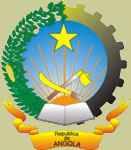|
|
| Colours of Angola flag |
 The National Flag shall consist of two colors in horizontal bands. The upper
band shall be bright red and the lower one black and they shall represent:
The National Flag shall consist of two colors in horizontal bands. The upper
band shall be bright red and the lower one black and they shall represent:
Bright red - The blood shed by Angolans during colonial oppression, the national liberation struggle and the defense of the country. Black - The African continent. In the center there shall be a composition formed by a segment of a cogwheel, symbolizing the workers and industrial production, a machete, symbolizing the peasants, agricultural production and the armed struggle, and a star, symbolizing international solidarity and progress. The cog wheel, the machete and the star shall be yellow, symbolizing the country's wealth. Source: the Constitution of Angola. |
| Coat of Arms of Angola |
 The
insignia of the Republic of Angola shall be formed by a segment of a cogwheel
and sheaves of maize, coffee and cotton, representing respectively the workers
and industrial production, the peasants and agricultural production. The
insignia of the Republic of Angola shall be formed by a segment of a cogwheel
and sheaves of maize, coffee and cotton, representing respectively the workers
and industrial production, the peasants and agricultural production. At the foot of the design, an open book shall represent education and culture, and the rising sun shall represent the new country. In the center shall be a machete and a hoe symbolizing work and the start of the armed struggle. At the top shall be a star symbolizing international solidarity and progress. In the lower part of the emblem shall be a golden band with the inscription 'Republic of Angola'. Source: the Constitution of Angola. |
| People of Angola |
 Population: 10,366,031 (July 2001 est.)
Population: 10,366,031 (July 2001 est.) Age structure: 0-14 years: 43.31% (male 2,266,870; female 2,222,262) 15-64 years: 53.98% (male 2,847,089; female 2,748,091) 65 years and over: 2.71% (male 127,798; female 153,921) (2001 est.) Population growth rate: 2.15% (2001 est.) Birth rate: 46.54 births/1,000 population (2001 est.) Death rate: 24.68 deaths/1,000 population (2001 est.) Net migration rate: -0.34 migrant(s)/1,000 population (2001 est.) Sex ratio: at birth: 1.05 male(s)/female under 15 years: 1.02 male(s)/female Ethnic groups: Ovimbundu 37%, Kimbundu 25%, Bakongo 13%, mestico (mixed European and Native African) 2%, European 1%, other 22% Religions: indigenous beliefs 47%, Roman Catholic 38%, Protestant 15% (1998 est.) Languages: Portuguese (official), Bantu and other African languages |

